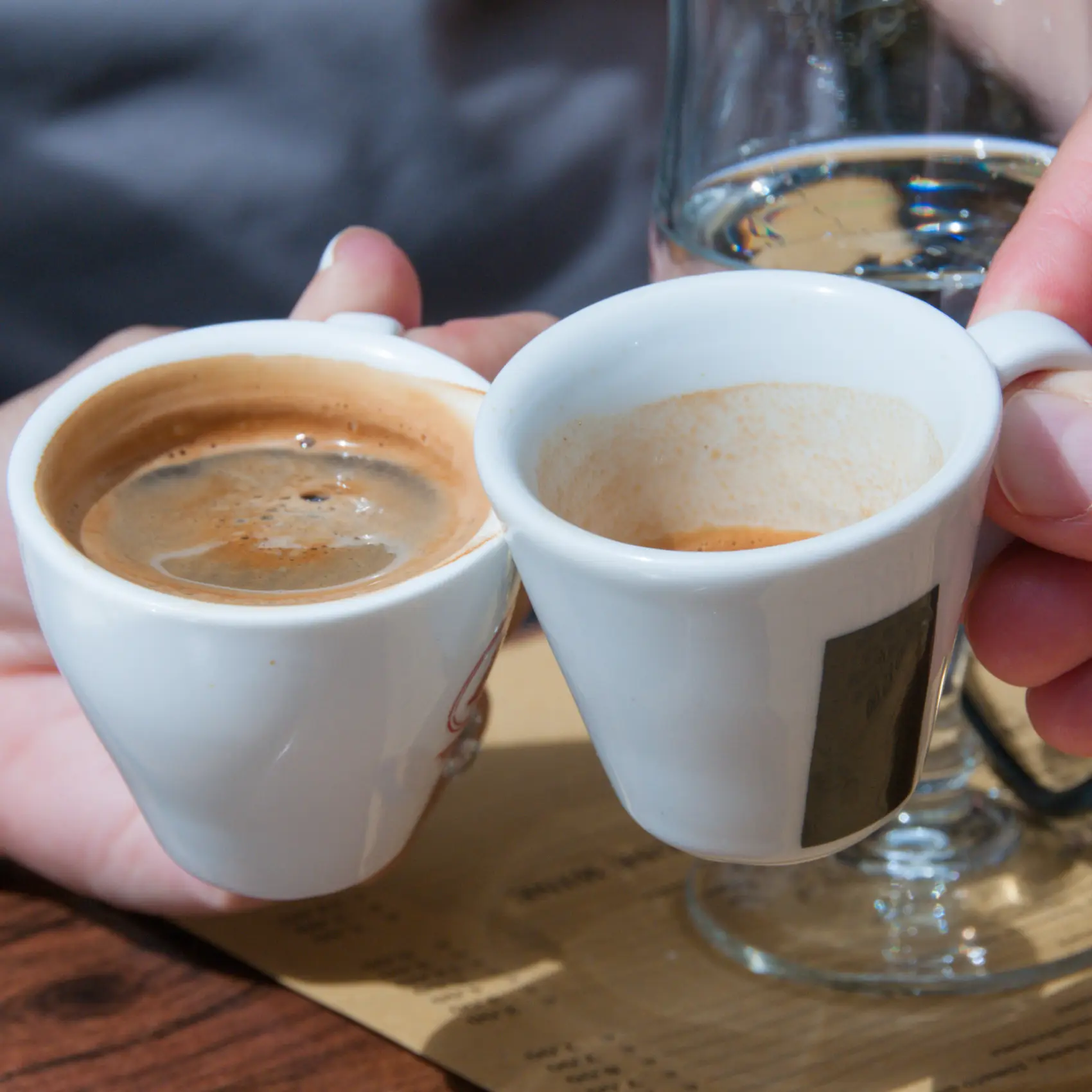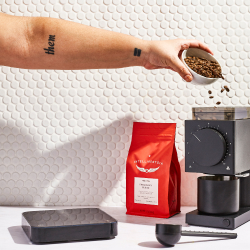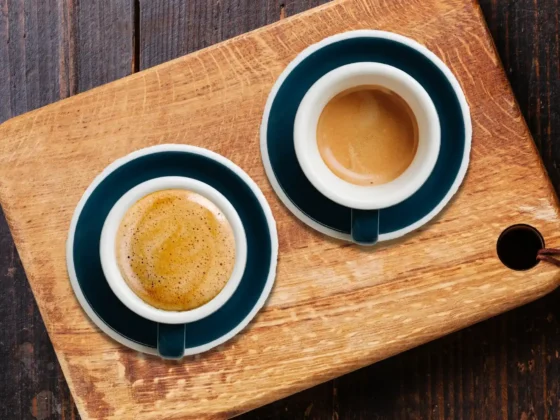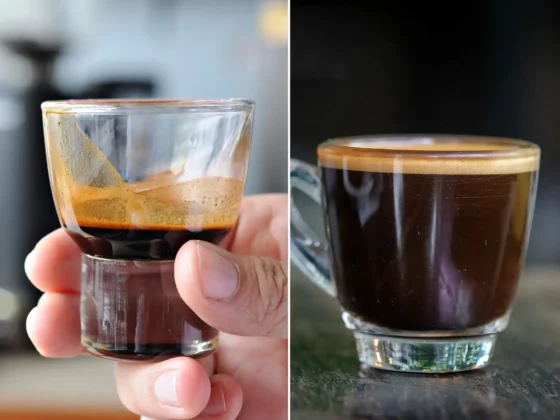The world of coffee is an intricate tapestry of flavors, techniques, and traditions. As aficionados and casual drinkers alike navigate this vast realm, the ristretto vs espresso debate frequently emerges as a topic of spirited discussion. Both these brews encapsulate coffee’s robust spirit, yet each boasts its unique nuances. From their distinct brewing methodologies and tasting notes to their varying popularity across global coffee cultures, these beverages are emblematic of the rich essence that coffee brings to our cups. This article delves deep into the heart of this debate, exploring the intricate facets of these beloved brews. Whether you’re a seasoned barista or a curious coffee enthusiast, come journey with us as we unravel the mystique behind ristretto and espresso.
Audiobook enthusiasts, rejoice! Enjoy the article in audio clips below.
- Introduction & Key Takeaway
- https://app.mysoundwise.com/tracks/16978447938719136e.mp3
- What is Espresso?
- https://app.mysoundwise.com/tracks/16978475698652300e.mp3
- What is a Ristretto?
- https://app.mysoundwise.com/tracks/16978475967786311e.mp3
- Ristretto vs Espresso: Tasting Notes
- https://app.mysoundwise.com/tracks/16978478042476414e.mp3
- Caffeine Content and Health Benefits
- https://app.mysoundwise.com/tracks/16978476222718015e.mp3
- Brewing Ristretto & Espresso
- https://app.mysoundwise.com/tracks/16978478256508630e.mp3
- Popularity and Variations
- https://app.mysoundwise.com/tracks/16978478864434949e.mp3
- Conclusion & FAQs
- https://app.mysoundwise.com/tracks/16978479050878853e.mp3
Espresso vs Ristretto: Key Takeaway
- Brewing Techniques: Ristretto and espresso differ in water usage and extraction time. Espresso uses more water and takes 25-30 seconds, while ristretto is quicker, using less water and brewing in 15-20 seconds.
- Flavor Differences: Ristrettos are typically sweeter and less acidic due to their shorter extraction period. Whereas espressos can have deeper, slightly more bitter undertones.
- Health Factors: While espresso and ristretto come with their own caffeine concentrations, they both offer a range of health benefits including antioxidants and positive mental health effects.
- Equipment and Techniques: Achieving the perfect espresso or ristretto shots needs calibrated machines and grinders. Grind size, water temperature, and pressure are vital for quality.
- Popularity and Variations: Espresso is globally popular, forming the base for many coffee drinks. Ristretto is rising in specialty cafes, highlighting coffee’s diverse range.
What is Espresso?

Espresso phonetically articulated as ess-PRESS-oh, is a cherished coffee preparation technique stemming from Italy. This concentrated version of coffee is dispensed in “shots,” arising from pushing nearly boiling water under pressure through finely ground coffee beans. The final product is a robust coffee liquid adorned with a “crema”—a frothy layer derived from the fusion of air bubbles and coffee’s soluble oils. This distinguishing crema not only adds a visual appeal but also intensifies the overall flavor profile of espresso. (1)
Historical Roots of Espresso
Diving into the annals of espresso reveals a captivating narrative. Originating approximately a century back in Italy, it owes its conception to an innovator named Luigi Bezzera from Milan.
- Steam-Pressure Method: Bezzera is credited with the introduction of the steam-pressure brewing method. This innovative approach enabled the production of a strong coffee blend in an impressively short span.
- Meaning of Espresso: The term “Caffé espresso” translates to “pressed-out coffee.” This nomenclature pays homage to the unique preparation technique that employs high pressure to force water through the finely milled coffee. DID YOU KNOW? A common mispronunciation of “espresso” is “expresso.” While “espresso” refers to the method of brewing, “expresso” is a non-standard variant and is not used in traditional coffee terminology. For a deeper dive into the differences, check out our article on Espresso vs. Expresso.
- Refinements Over Time: By the 1940s, the espresso crafting methodology had undergone significant refinements, solidifying its position as the gold standard in coffee brewing worldwide.
In essence, espresso’s historical lineage is deeply intertwined with Italian innovations, having evolved considerably over the decades to the delight of coffee connoisseurs.
Brewing the Perfect Espresso
The art of brewing espresso requires meticulous attention to detail. It’s not merely about forcing water through coffee grounds but involves precise variables that ensure perfection in every shot.
- Extraction Techniques: The fundamental principle behind espresso is pressing hot water with substantial force through densely packed, finely ground coffee. Guidelines often suggest specifics about the coffee quantity, water temperature and pressure, and the extraction duration.
- Espresso Machines: While traditional “pulling” methods entailed manual effort, modern espresso extraction largely capitalizes on electric pumps, ensuring consistent pressure.
- Significance of Crema: A hallmark of well-brewed espresso is the presence of crema. This frothy layer, unique to the espresso brewing process, arises from the high-pressure water facilitating more carbon dioxide dissolution, an inherent compound in coffee from the roasting phase.
- Authenticity Parameters: The Italian Espresso National Institute has set particular criteria that delineate what constitutes a genuine Italian espresso, encompassing aspects from bean quality to extraction dynamics. (2)
In summation, brewing the quintessential espresso shot demands a harmonious blend of the right equipment, impeccable technique, and a touch of passion.
How to Drink Espresso

When it comes to enjoying espresso, there’s a finesse to savoring its richness. Despite its diminutive size, it’s not a beverage to be gulped down hurriedly.
- Sip Slowly: Contrary to its “shot” moniker, espresso calls for measured sipping, allowing one to revel in its multifaceted flavors.
- Customizations: While many aficionados appreciate their espresso unadulterated, others may opt for a dash of sweetener or even a double shot to suit their palate.
- Complementary Delights: It’s commonplace to pair espresso with a delectable side, like the ever-popular biscotti.
Thus, understanding how to drink espresso enhances the overall experience, transforming it from a mere beverage to a cherished ritual.
Espresso in Modern Coffee Culture
Espresso’s influence extends far beyond Italy, having cemented its position in global coffee culture. Its potency and versatility make it a staple in numerous coffeehouses around the world.
- Base for Beverages: Espresso serves as the foundation for a myriad of popular café drinks.
- Notable examples include:
- Caffé Americano: A harmonious blend of espresso and hot water.
- Red-eye: A fusion of conventional coffee with an espresso shot.
- Caffé latte: A combination of two espresso shots topped with steamed milk.
- Cappuccino: Espresso crowned with a blend of steamed and frothy milk.
- Global Appeal: Although its roots are distinctly European, the reach of espresso is undeniably global. Its unique preparation method and the array of types of espresso drinks have played a pivotal role in its worldwide acclaim.
Overall, espresso continues to shape modern coffee culture, reflecting both its storied past and its adaptability to evolving tastes and preferences.
What is a Ristretto?
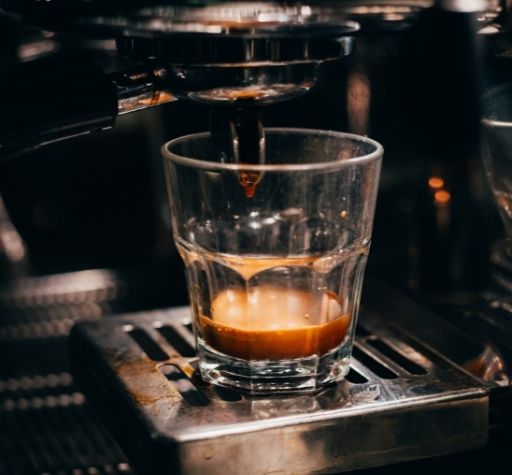
In the world of coffee, a Ristretto holds a prestigious place, distinguishing itself as a more concentrated version of espresso. Drawing from the Italian term meaning “limited,” a ristretto shot offers a limited water volume compared to its espresso counterpart. This reduction in water emphasizes the flavors of the coffee beans used, leading to an intense experience that brims with boldness and rich undertones. Many regard the ristretto as the epitome of espresso, offering a luxurious tasting experience that shines the spotlight on the coffee’s nuanced characteristics.
The Birth of Ristretto
Tracing back to its roots, the ristretto emerged in Italy during the early 20th century. This brewing technique was birthed out of necessity and innovation, primarily because of:
- Economic Constraints: During World War II, the limited availability and increasing costs of coffee beans prompted cafes to use fewer grounds. This gave birth to a richer brew, which eventually became recognized as the ristretto method.
- Flavorful Reception: Despite its birth out of necessity, the ristretto’s unique and potent flavor quickly won over the hearts of coffee connoisseurs. This intensified espresso variant accentuated the coffee bean’s subtle notes, making it an instant favorite.
- Upscale Perception: Over time, ristrettos gained traction and were deemed as a more refined version of the standard espresso. Today, it’s seen as a luxury in the coffee world, cherished for its unmatched flavor spectrum.
Summing up, the ristretto, born from economic challenges, rose in stature to become a beloved brew for those seeking an elevated coffee experience.
Mastering Ristretto Brewing
Understanding how to craft the perfect ristretto shot is pivotal for relishing its distinct taste. Here’s a closer look at its brewing process:
- Brewing Basics: Utilizing the same amount of coffee as one would for an espresso, a ristretto’s defining feature is its brewing duration. Limited to just 15-20 seconds, this shortened time is contrasted with the typical 20-30 seconds for a regular espresso.
- Coffee-to-Water Ratio: Striking the right balance is key. Generally, a 1:1 to 1:2 coffee-to-water ratio is employed, translating to about 15 grams of coffee for every 15 grams of water extracted.
- The Outcome: Due to its succinct brewing time, a ristretto shot possesses roughly half the volume of a regular espresso. However, its flavor is much more profound, with the concise brewing curtailing the extraction of bitter compounds, offering a sweeter, richer taste.
To truly appreciate a ristretto, it’s vital to adhere to these brewing techniques, ensuring that every sip is a journey into the depth of the coffee’s essence.
How to Drink Ristretto

Embarking on the ristretto experience is unique. Here’s a guide on how to drink ristretto and immerse yourself in its flavors:
- Serving Style: When it comes to the serving style of unadulterated ristrettos, a demitasse cup is the vessel of choice, and these shots are enjoyed in their pure form, without the addition of milk or water. (3)
- Accompaniments: While some prefer to savor the ristretto shot unadulterated, others opt to pair it with a side of water or even introduce a splash of milk or cream to enhance its sweetness.
- Savoring the Flavor: Stir the crema gently, take a sip, and let the flavors dance on your palate. Given the small volume, a ristretto is typically consumed in two or three sips, making every moment count.
In essence, whether you’re a coffee novice or a seasoned aficionado, understanding how to drink ristretto can elevate your coffee journey, offering a taste of luxury with every sip.
Ristretto’s Place in Contemporary Café Society
In today’s café culture, the ristretto holds a revered position. While many traditionalists prefer it in its authentic form, others have adapted it to contemporary tastes:
- Versatile Base: Ristretto serves as a foundation for many popular beverages, including cappuccinos, lattes, and occasionally flat whites. The milk in these blends highlights the espresso’s inherent sweetness.
- Trend Dynamics: The idea of adding milk hasn’t become universally popular, with many establishments and coffee lovers advocating for the drink’s pure form to be appreciated.
- Tasting Evolution: As with all things coffee, tasting evolves. With ristretto, allowing it a moment post-extraction often unveils a symphony of intensified flavors.
In sum, ristretto, with its rich history and unique brewing method, has solidified its presence in modern coffee culture, bridging the gap between tradition and contemporary tastes.
Ristretto vs Espresso: Tasting Notes
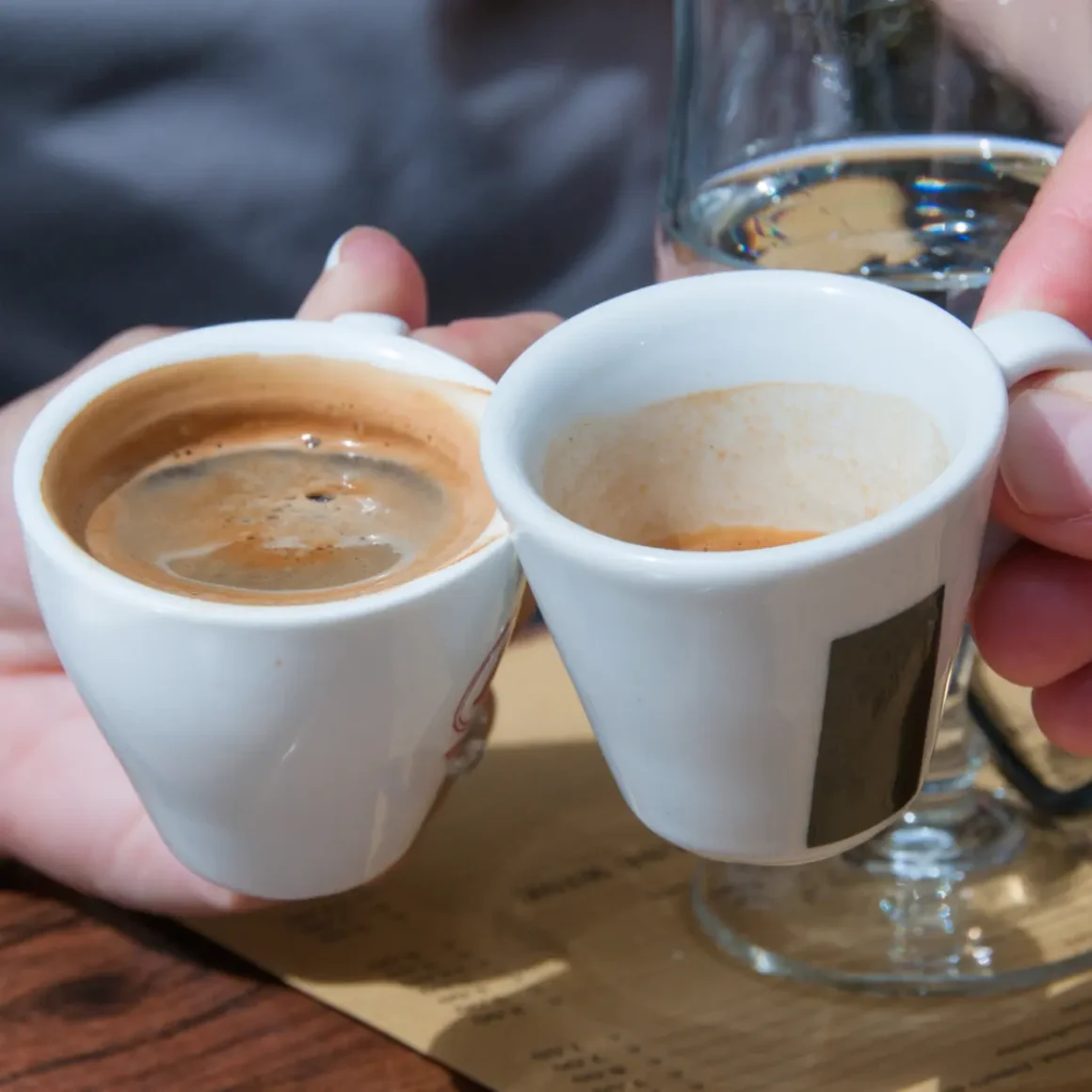
Diving deep into the world of coffee, one finds themselves amidst a myriad of flavors, aromas, and brewing techniques. Two particular stars in this universe, ristretto and espresso, have long been the subject of passionate discussions among coffee connoisseurs. Both drinks originate from similar roots but differ remarkably in their flavor profiles and preparation methods. This segment aims to explore these nuanced differences, allowing readers to gain a comprehensive understanding of these cherished beverages.
Understanding Coffee Profiles
Coffee, a beloved global beverage, offers an expansive variety of flavors and aromas depending on numerous factors, such as bean origin, roast, grind size, and brewing method. At the heart of distinguishing between ristretto and espresso lies a deep understanding of their distinct profiles:
- Brewing Technique: Both ristretto and espresso utilize finely-ground coffee beans. However, the difference emerges in the water quantity and extraction time. As previously discussed, espresso generally employs a standard amount of water, with the brewing process lasting 25-30 seconds. In contrast, ristretto uses significantly less water and is brewed for a brisk 15-20 seconds.
- Flavor Nuances: The water-to-coffee ratio and brewing time greatly influence the taste. Ristretto coffee boasts sweeter and less acidic notes, with fruity undertones being more pronounced. On the other hand, espresso drinks can display a wider spectrum of flavors, ranging from fruity to chocolatey and even slightly bitter.
- Volume Differences: Due to the variations in water content, ristrettos are denser and often come in smaller volumes compared to espressos. This doesn’t mean a compromise on flavor; ristrettos still pack a punch with their robust taste.
In a nutshell, while both drinks share common ground, understanding their profiles helps distinguish one from the other, enhancing the coffee experience for enthusiasts.
The Sensory Experience: Flavor, Aroma, and Body
When it comes to coffee, the journey isn’t just about taste; it encompasses a full sensory experience. Let’s break this down:
- Flavor: As previously mentioned, ristretto is known for its intense sweetness, reduced acidity, and pronounced fruity notes. Espresso, while also rich, tends to have a broader flavor spectrum which can include bitter or chocolatey undertones.
- Aroma: Ristrettos, due to their shorter extraction, present a distinct combination of fragrances. Fewer chemical compounds mean a cleaner aroma, highlighting the bean’s inherent scents. Espresso drinks, with a longer extraction time, may offer a more complex aromatic profile.
- Body: In terms of texture, ristretto coffee usually has a thicker, creamier body compared to espresso, mainly due to its concentrated nature and rich crema.
In essence, both drinks offer a multi-layered sensory experience. Whether it’s the robust taste, alluring aroma, or velvety texture, both ristretto and espresso stand tall in their own right.
Pairing Suggestions for Ristretto and Espresso
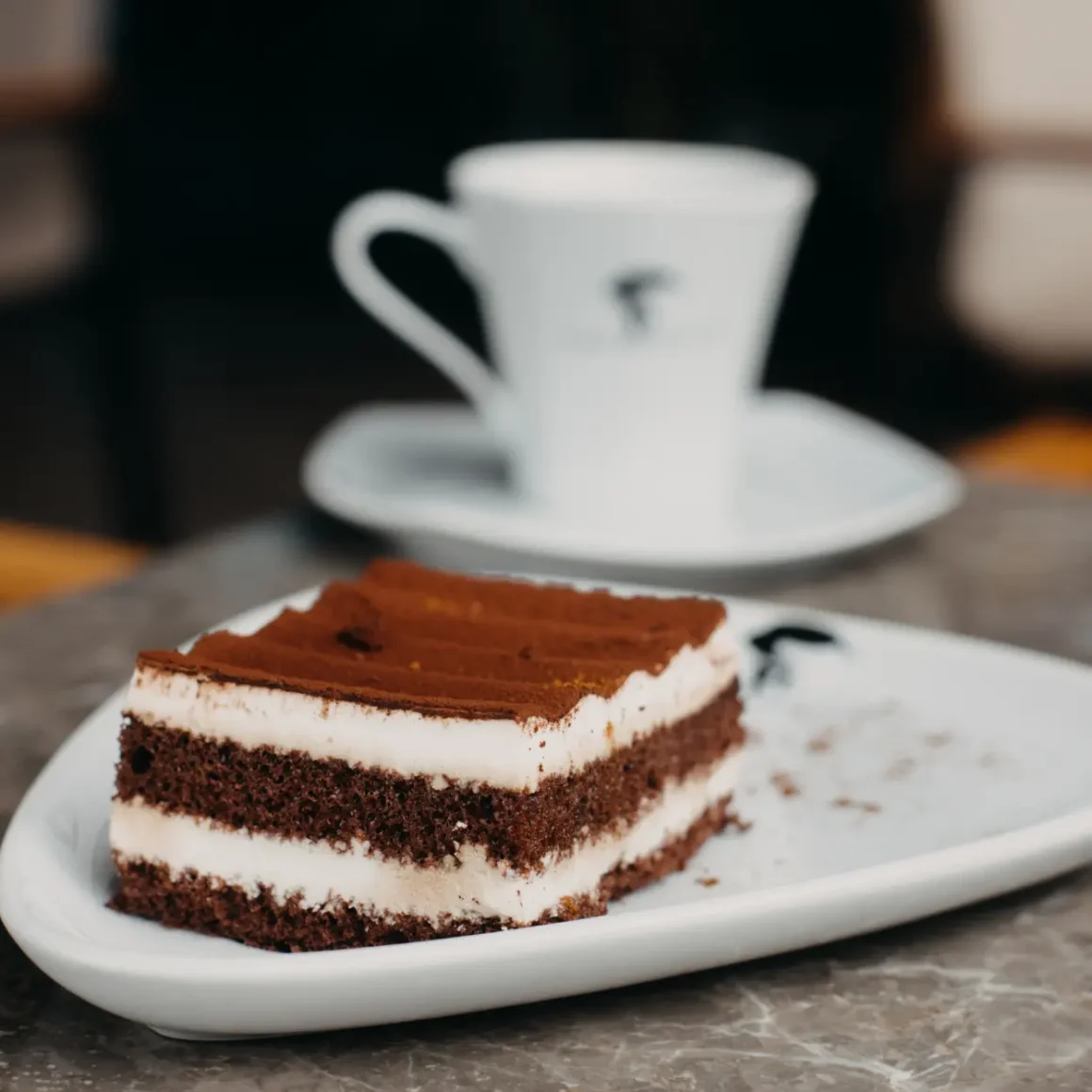
The robust flavors of ristretto and espresso can be complemented by a variety of accompaniments. Here are some suggestions to enhance your coffee experience:
- For Ristretto: Given its intense flavor profile, ristretto pairs well with:
- Light pastries or croissants, which can balance its strong taste.
- Dark chocolate, echoing its inherent sweet notes.
- For Espresso: Given its broader flavor range, espresso drinks can be paired with:
- Nutty desserts or almond biscotti, complementing its deep tones.
- Cream-based desserts like tiramisu, adding a smooth contrast.
Pairing coffee with the right foods not only enhances its taste but also elevates the overall drinking experience. Whether you’re indulging in a ristretto or an espresso, the right accompaniment can make all the difference.
Caffeine Content and Health Benefits

The realm of coffee is vast and alluring, with each variant offering unique flavors and characteristics. But beyond taste, coffee is also known for its caffeine content and an array of health benefits. In this section, we’ll delve into the caffeine levels of ristretto and espresso and uncover the plethora of benefits that these popular coffee types bring to our health and minds.
Caffeine Content in Ristretto and Espresso
In the grand tapestry of coffee, caffeine often stands out as a dominant thread. While many associate espresso with high caffeine, the truth revolves around its quantity:
- Espresso: Espresso might come in a small package, but it’s mighty in its caffeine punch. On average:
- A single espresso shot contains approximately 29 to 100 milligrams of caffeine, with 75 milligrams being a common measurement.
- Those who prefer a double shot can expect around 58 to 185 milligrams of caffeine.
- By comparison, standard drip coffee ranges from 80 to 200 milligrams of caffeine per cup, depending on various brewing factors.
- Ristretto: As a concentrated variant of espresso, ristretto is often perceived to be high in caffeine. However:
- A standard ristretto shot, with its 20-milliliter volume, provides roughly 33 milligrams of caffeine.
- For those seeking a more intensified experience, a double-shot ristretto offers approximately 66 milligrams of caffeine.
In essence, while both ristretto and espresso are rich in flavor, their caffeine content is shaped by their brewing techniques and serving sizes. It’s crucial for individuals to be aware of their own caffeine sensitivities and adjust their consumption accordingly.
Antioxidants and Other Health Benefits
Coffee is not just about caffeine; it’s a treasure trove of antioxidants and health advantages:
- Rich in Antioxidants: Both ristretto and espresso are rich in compounds that counteract the harmful effects of free radicals. These antioxidants play a pivotal role in reducing inflammation and combating chronic diseases.
- Supports Metabolism: Caffeine is known to stimulate metabolism, aiding in weight management and calorie burning. (4)
- Heart Health: Moderate coffee consumption has been associated with a reduced risk of heart disease.
- Liver Benefits: Regular intake of coffee has shown potential in reducing the risk of liver diseases, including liver cancer.
While moderation is key, coffee, when consumed judiciously, can offer an array of health benefits, making it a delightful and healthful addition to our daily routines.
The Mind-Coffee Connection: Mental Health Benefits
The allure of coffee goes beyond its rich aroma and invigorating taste. Delve deeper, and you’ll discover a fascinating interplay between coffee and mental well-being:
- Mood Enhancer: Caffeine stimulates the release of neurotransmitters like dopamine and serotonin, which can uplift mood and combat feelings of depression.
- Enhanced Concentration: Regular coffee drinkers often report heightened alertness and improved concentration, courtesy of caffeine’s stimulating effects.
- Reduced Risk of Neurological Diseases: Some studies suggest that regular coffee consumption may reduce the risk of neurodegenerative diseases like Parkinson’s and Alzheimer’s.
- Memory Boost: Caffeine has shown potential in enhancing short-term memory, making tasks and recall easier for individuals.
In wrapping up, it’s evident that coffee, with its rich blend of caffeine and antioxidants, not only invigorates the body but also nurtures the mind, offering a holistic wellness experience.
Brewing Ristretto & Espresso: Tools of Precision and Taste
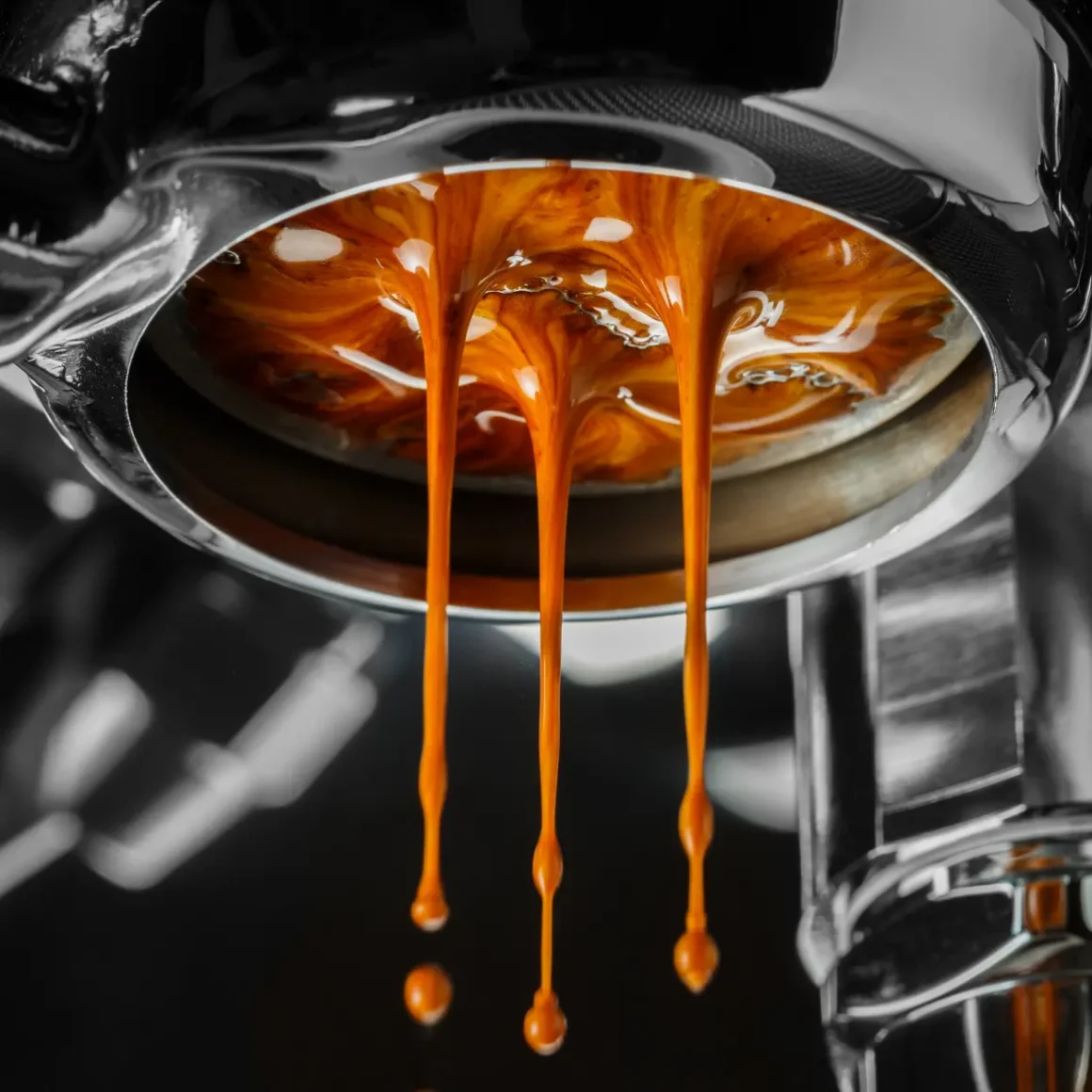
The journey to a perfect cup of ristretto or espresso isn’t just about the beans or the roast; it’s significantly influenced by the brewing tools and techniques employed. Here, we focus on the specialized equipment that gives these concentrated coffee shots their distinct character and depth.
Essential Coffee Brewing Equipment for Ristretto & Espresso
Delving into the world of ristretto and espresso requires specific tools that are tailored to achieve the dense and aromatic shots unique to these brews:
- Espresso Machine: At the core of an authentic ristretto or espresso is a high-quality espresso machine. Modern machines are equipped with advanced features like precise temperature control, pressure gauges, and sometimes even built-in grinders to enhance the brewing experience.
- Capsule Machines (e.g., Nespresso): For those seeking convenience without much fuss, capsule machines offer a quick solution. While they may not always capture the authentic depth of a traditional espresso or ristretto, they provide a decent approximation, especially for the untrained palate.
Understanding and investing in the right equipment is paramount. It’s the bridge between a good coffee shot and an unforgettable one.
The Art and Science of Coffee Grinding for Espresso Brews
Beyond the machine, the grind plays a pivotal role in determining the quality of your ristretto or espresso:
- Burr Grinders: The preferred choice for espresso aficionados. Burr grinders offer a consistent and even grind, which is crucial for a balanced shot.
- Grind Size Matters: Espresso and ristretto demand a fine grind. This ensures a smooth flow of water through the coffee grounds, achieving a concentrated shot full of flavor.
- Freshness: As with all coffee brews, freshly ground beans offer the richest aromas and flavors. Grinding right before brewing can elevate the quality of your shot.
Mastering the Technique: Brewing Ristretto & Espresso
With the right equipment and grind, the final piece of the puzzle is technique. Here’s what you need to keep in mind:
- Water Quality: Pure, filtered water can make a world of difference in the taste of your espresso or ristretto.
- Temperature Control: The optimal temperature for espresso brewing lies between 195-205°F. A consistent temperature ensures a well-extracted shot.
- Brewing Time: For espresso, a pull of 25-30 seconds is ideal. Ristretto, being a shorter shot, typically takes a slightly shorter time.
When it comes to ristretto and espresso, precision is everything. The right equipment, grind, and technique can transport you to coffee heaven with every shot.
Popularity and Variations
Coffee, with its enchanting aroma and invigorating flavor, has charmed generations and traversed continents. Over time, as cultures embraced and experimented with it, myriad variations were born. Among these, espresso coffee drinks have stood out as globally cherished concoctions. From the concentrated brilliance of the ristretto to the versatile espresso, the world of coffee offers a captivating tapestry of tastes and textures.
Espresso Worldwide: From Crema to Creations
The espresso is much more than a mere beverage; it’s a cultural emblem representing coffee in its purest form. Its global appeal is evident in how different cultures have adopted and adapted it:
- Italy: The birthplace of espresso. Served in small cups, it’s often enjoyed multiple times a day, usually without milk or sugar. The crema on top is a sign of a well-brewed shot.
- Australia and New Zealand: Flat white, essentially an espresso with microfoam, originated here. It’s smoother than a cappuccino and has gained global recognition.
- Sweden: Here, the ‘kaffe latte’ is quite popular, a mild version of the latte, underscoring the country’s love for milder best coffee experiences.
- Spain: The ‘café con leche’ or coffee with milk, typically involves equal parts of espresso and steamed milk, a hearty and robust coffee delight.
To sum up, espresso forms the backbone of many of the world’s most beloved beverages. Its versatility and intense flavor make it a favorite foundation upon which countless variations have been built.
Ristretto’s Comeback: A Trend in Specialty Cafes
The ristretto, an intense and flavorful variation of the espresso, had for a while been overshadowed by its more popular sibling. However, recently, it’s making waves in the coffee community:
- Specialty Cafes: These hubs for coffee aficionados emphasize the quality and nuances of their brews. Ristretto, with its bold profile, is often a highlight here.
- A Sweeter Shot: The ristretto’s shorter extraction time reduces its acidity, making it naturally sweeter, an attribute that’s winning over many palates.
- Quality Over Quantity: Given its concentrated nature, ristretto is viewed by many as the essence of the coffee bean, capturing its core flavors in a small, potent shot.
Overall, the ristretto’s resurgence in the coffee world is a testament to its distinct and captivating taste. Specialty cafes, with their emphasis on quality and experimentation, are leading the charge in reintroducing this gem to coffee enthusiasts.
Unique Takes on Espresso and Ristretto

Both espresso and ristretto serve as foundational elements for myriad creative coffee concoctions around the world:
- Cortado: A harmonious blend of espresso and a small amount of warm milk to reduce its acidity, often served in a special glass, originating from Spain.
- Lungo: An ‘elongated’ espresso where more water is passed through the coffee grounds, giving a milder flavor compared to the ristretto and classic espresso. For a comprehensive comparison between the two, explore our article titled “Lungo vs. Espresso.”
- Espresso Romano: An intriguing combination where a slice of lemon is served on the side or the rim of the cup is rubbed with lemon to complement the espresso’s bitterness.
- Espresso con Panna: Espresso topped with a dollop of whipped cream, blending the rich flavors of coffee with the creamy sweetness.
In wrapping, the realm of coffee is as vast as it is varied. Espresso and ristretto, with their concentrated flavors, act as pillars supporting an expansive and ever-evolving world of caffeinated creativity.
Conclusion
Navigating the multifaceted world of coffee can often feel like traversing a vast landscape filled with hidden gems. Central to this journey is the ristretto vs espresso debate, a testament to the depth and diversity of the coffee culture. We’ve delved into their unique brewing techniques, tasted their contrasting flavor profiles, and traced their popularity and innovative variations across the globe.
While espresso has long enjoyed worldwide acclaim with its robust flavors and myriad creations, ristretto is making a notable comeback in specialty cafes, showcasing the ever-evolving palate of coffee enthusiasts. Ultimately, the choice between ristretto and espresso boils down to personal preference, but understanding their rich essence and nuances only enhances our appreciation. As we conclude our exploration, it’s evident that both these brews, in their own right, encapsulate the passion, science, and artistry that make coffee such a universally cherished beverage.
Interested in discovering how the Espresso or Ristretto compares to other coffee drinks? Be sure to explore our additional comparison guides:
FAQ
How does the grind size affect the quality of Ristretto and Espresso?
The grind size is crucial; too coarse can lead to under-extraction while too fine can cause over-extraction, impacting the flavor and quality.
What are the cultural significance of Ristretto and Espresso in Italy?
In Italy, both ristretto and espresso are integral to daily life, symbolizing moments of leisure, socialization, and traditional coffee craftsmanship.
Which coffee variant, Ristretto or Espresso, contains more caffeine and why?
Espresso generally contains more caffeine because of its larger volume, even though ristretto is more concentrated.
What are some popular coffee concoctions that use Ristretto or Espresso as a base?
Popular concoctions include cappuccinos, lattes, Americanos, and macchiatos, all of which can be made using either ristretto or espresso as the base.
